Immerse yourself in Ruth's biblical journey, where loyalty defies boundaries and destiny unfolds in unexpected ways.
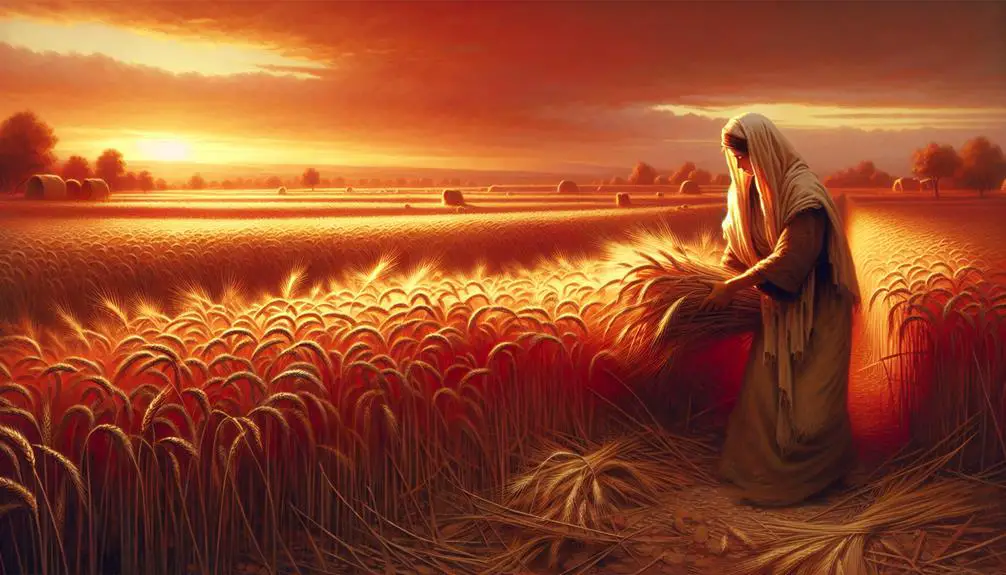
Picture of Ruth in the Bible
The narrative of Ruth in the Bible offers a compelling exploration of loyalty, resilience, and the unexpected pathways by which divine providence unfolds. A Moabite by birth, Ruth's journey from widowhood in a foreign land to her pivotal role in the lineage of David—and by extension, the genealogy of Jesus Christ—raises intriguing questions about faith, cultural boundaries, and the essence of true kinship.
As we examine Ruth's vow of loyalty that transcends familial obligation and her eventual integration into the community of Bethlehem, one is prompted to reconsider the dimensions of faithfulness and the profound impact of seemingly ordinary decisions.
The story of Ruth, while ancient, beckons a contemporary audience to explore the layers of meaning that continue to resonate within our own lives.
Key Takeaways
- Ruth's story showcases her cultural integration and acceptance, emphasizing unity across different backgrounds.
- Her legacy of faithfulness profoundly impacts future generations, illustrating divine providence in her lineage.
- The relationship dynamics between Ruth and Boaz challenge societal norms, highlighting inclusivity and mutual respect.
- Ruth's enduring faithfulness and divine intervention in her story offer timeless insights into divine-human interaction.
The Moabite Connection

Ruth's heritage as a Moabite plays a pivotal role in understanding her story within the broader context of Biblical narratives, highlighting themes of inclusion and the breaking of cultural barriers. The Book of Ruth, set against the backdrop of the Judges era, not only presents a personal story of loyalty and devotion but also addresses the broader implications of Moabite ancestry in Israelite society. The significance of Ruth's Moabite background is underscored by the historical animosity between Israel and Moab, making her acceptance into Bethlehem's community a testament to the overcoming of deeply ingrained prejudices and cultural differences.
Analyzing Ruth's integration into Israelite society offers insights into the dynamics of cultural assimilation and the potential for inclusivity within religious and ethnic identities. Her story challenges the traditional boundaries that defined community membership, suggesting a theological openness to the other. This is particularly remarkable considering the legal and social constraints placed on Moabites, as depicted in Deuteronomy 23:3-6, which prohibited their entry into the assembly of the Lord.
Furthermore, Ruth's Moabite ancestry becomes a conduit for exploring the theme of divine providence and the unexpected ways through which God fulfills His purposes. Her inclusion in the genealogy of David, and ultimately Jesus, as outlined in Matthew 1:5, underscores the transformative power of faith and loyalty that transcends cultural and ethnic divides. Thus, Ruth's story serves as a critical reflection on the complexities of identity, belonging, and the inclusivity of divine promise, challenging the readers to reconsider the implications of cultural differences in their understanding of community and divine purpose.
A Vow of Loyalty
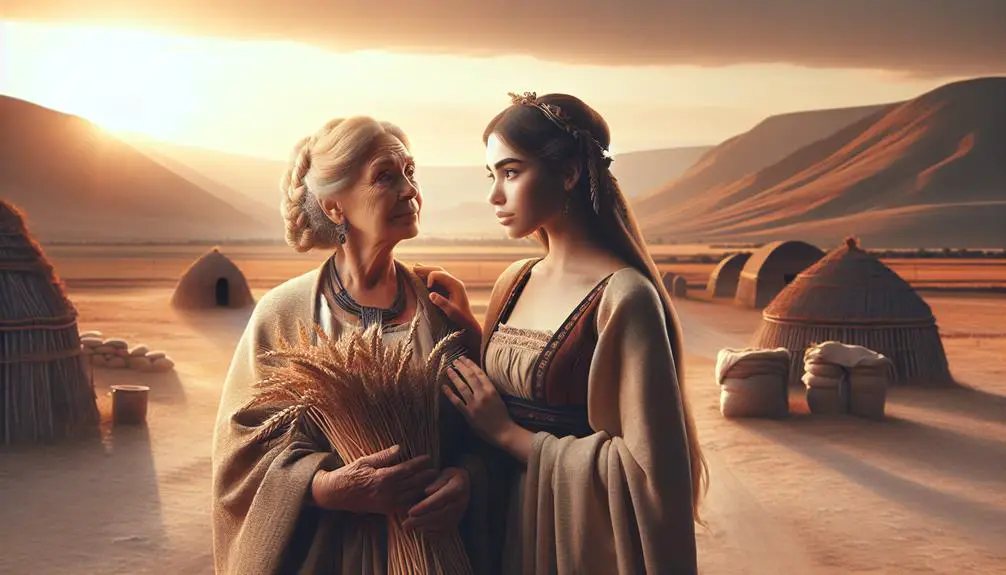
Reflecting on the significance of cultural assimilation previously discussed, a pivotal moment in understanding Ruth's character is her unwavering vow of loyalty, which not only defines her personal journey but also serves as a cornerstone in the narrative of inclusivity and faith within the biblical text. Ruth's commitment to Naomi, her mother-in-law, transcends cultural boundaries and religious implications, illustrating a profound bond that challenges societal norms of the time.
- Cultural Boundaries Overcome: Ruth's decision to stay with Naomi represents a crossing of cultural lines, showcasing her willingness to leave her Moabite identity behind.
- Religious Implications: Her vow signifies a conversion to Naomi's faith, illustrating the deep religious undertones of her loyalty.
- Personal Sacrifice: Ruth's loyalty entails personal sacrifice, as she forsakes her homeland and any prospect of remarriage within her native culture.
- Symbol of Unity: This act of loyalty becomes a symbol of unity and acceptance, highlighting the potential for harmony across different cultures and religions.
- Narrative of Faithfulness: Ruth's story emphasizes faithfulness, not only to individuals but also to new cultural and religious identities.
Ruth's vow of loyalty is a critical element in the biblical narrative, challenging readers to consider the power of loyalty, love, and faith across cultural and religious divides. Her story serves as an enduring testament to the strength of character and the ability of personal commitments to bridge seemingly insurmountable barriers, offering timeless lessons on inclusivity and the human capacity for empathy and understanding.
Harvest in Bethlehem
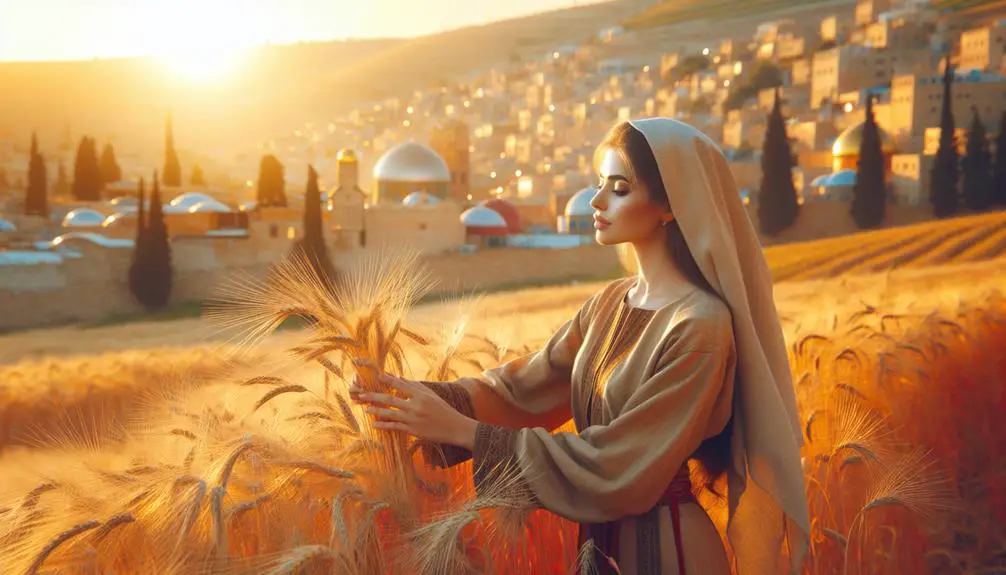
Upon arriving in Bethlehem, Ruth finds herself amidst the crucial period of harvest, a setting that not only frames her ensuing endeavors but also symbolizes a new beginning in her journey of loyalty and integration. The narrative backdrop of the harvest season in ancient Bethlehem provides a rich tapestry for exploring the agricultural practices and seasonal rituals that were central to the community's life and economy.
The harvesting period, typically occurring at the end of the dry season, was a time of intense labor and community cooperation. It involved the collective effort of reaping, threshing, winnowing, and storing crops, primarily barley and wheat, which were staples of the ancient Near Eastern diet. These agricultural practices were not merely economic activities but were imbued with religious significance, reflecting a profound connection between the people, their land, and their deity. Seasonal rituals, often accompanied by feasts and celebrations, marked the successful gathering of the harvest, expressing gratitude for divine provision and praying for future abundance.
Ruth's entry into this context underscores the themes of provision, redemption, and integration. By participating in the harvest alongside the Bethlehemites, she navigates the delicate process of integrating into a new community while adhering to its customs and contributing to its sustenance. Her actions during the harvest—gleaning in the fields as allowed for the poor and the stranger—highlight the ancient Near Eastern laws of hospitality and protection for the vulnerable, further embedding her story within the broader cultural and religious landscape of the time.
Bond With Boaz
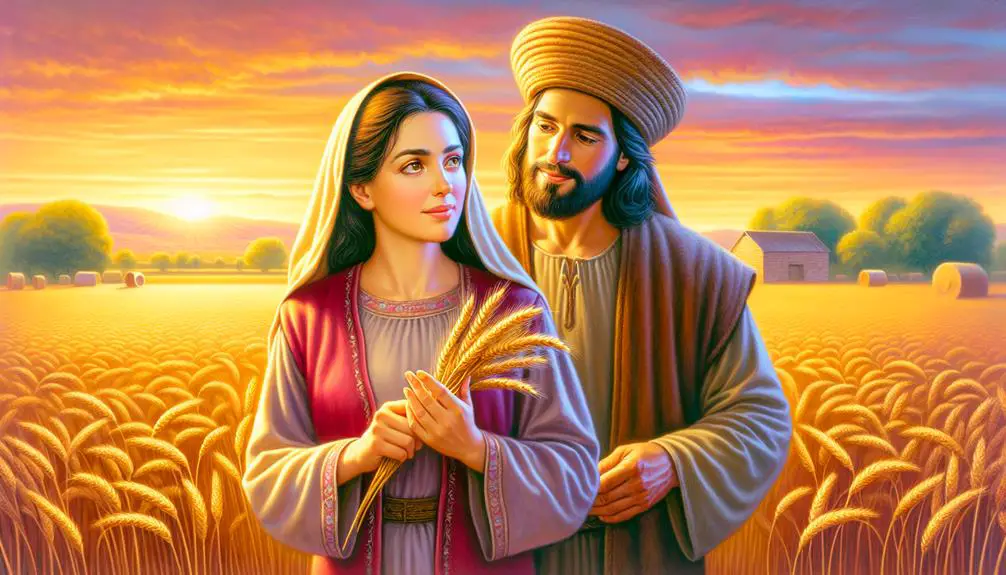
As Ruth immerses herself in the harvest activities of Bethlehem, her interactions with Boaz, a prominent figure in the community, begin to unfold, marking the start of a significant relationship that intertwines personal connection with communal and cultural implications. This bond between Ruth and Boaz is not just a personal narrative but also a lens through which the complexities of cultural barriers and marriage customs of the time are explored.
- Cultural Acceptance: Despite Ruth being a Moabite and thus an outsider, Boaz's acceptance and kindness towards her challenge the prevailing cultural barriers, setting an example of inclusivity.
- Protection and Provision: Boaz ensures Ruth's safety and well-being during the harvest, highlighting the societal expectations of men's roles towards vulnerable individuals in their midst.
- Marriage Customs: Their relationship progresses within the framework of Levirate marriage customs, underscoring the adherence to and flexibility of these traditions in accommodating love and duty.
- Social Status and Relationships: The evolving relationship between Ruth and Boaz illustrates how personal connections could transcend social hierarchies, albeit within certain cultural confines.
- Reciprocal Respect: Their mutual respect and kindness forge a strong connection, showcasing the importance of personal virtues in overcoming societal boundaries.
This bond serves not only as a personal triumph over adversity but also as a narrative device to delve into the norms, values, and customs of the time. Analyzing their relationship provides insight into how personal lives were intricately linked with and often reflective of broader societal structures and expectations, particularly concerning cultural barriers and marriage customs.
Legacy of Faithfulness
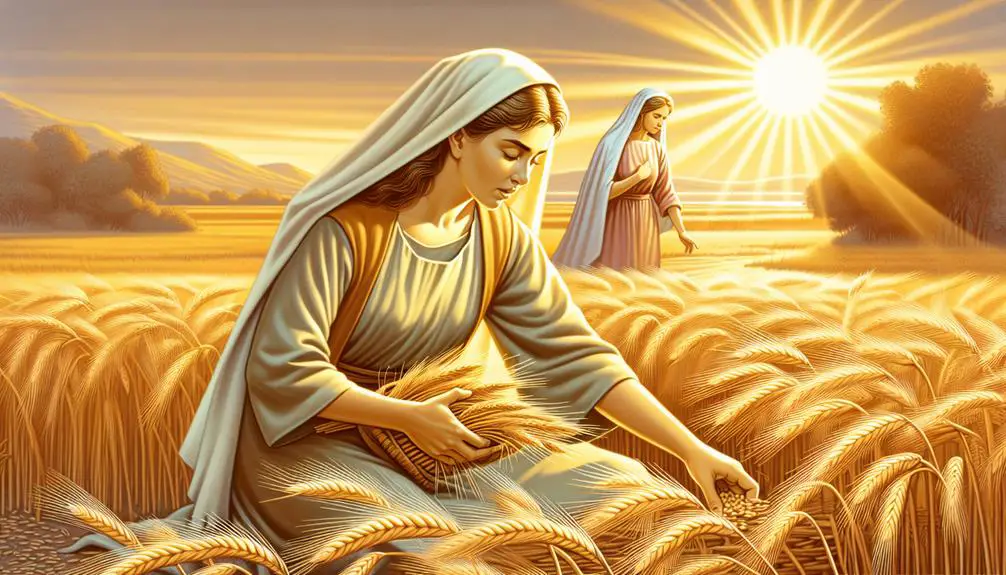
The legacy of faithfulness embodied by Ruth and Boaz transcends their personal narrative, setting a foundational example for subsequent generations on the intertwining of loyalty, moral integrity, and religious devotion within the context of their cultural and historical backdrop. Their story, deeply rooted in the Hebrew Scriptures, not only showcases the power of unwavering faithfulness but also highlights the role of divine intervention in the unfolding of human events. Ruth's unwavering commitment to Naomi and her God sets a precedent for understanding the depth of faith and the lengths to which it can inspire actions that bridge cultural divides and foster genuine connections.
Analyzing the ancestral lineage of David and, subsequently, Jesus Christ, one cannot overlook the significance of Ruth and Boaz's faithfulness as a cornerstone in this divine lineage. Ruth, a Moabite woman, integrates into the Israelite community through her marriage to Boaz, a union that was both a product of her loyalty and an act of divine providence. This integration underscores the inclusivity of God's plan and the importance of faithfulness that transcends ethnic and national boundaries.
Their legacy is not merely a tale of personal virtue but a narrative that enriches the theological understanding of God's workings through human history. By embedding the principles of loyalty, integrity, and devotion within the fabric of their lives, Ruth and Boaz exemplify the profound impact of living a life aligned with divine will. Their story serves as a testament to the enduring power of faithfulness, influencing not just their immediate context but offering timeless insights into the nature of divine-human interaction and the shaping of ancestral lineage through acts of faith.
Frequently Asked Questions
How Have Interpretations of Ruth's Story Evolved in Feminist Theological Studies?
In feminist theological studies, interpretations of Ruth's narrative have significantly evolved, emphasizing an exploration of gender dynamics and agency.
Scholars analyze Ruth's actions within her socio-historical context, highlighting her as a figure of resilience and autonomy. This analytical approach underscores how gender and power intersect in biblical texts, offering nuanced insights into Ruth's character.
Consequently, feminist theology has recontextualized Ruth's story, portraying her as a symbol of empowerment and agency.
What Are Some of the Common Misconceptions About Ruth's Role and Actions in the Bible?
One common misconception about Ruth pertains to her nationality, often underplayed, yet integral to her story's depth. Contrary to simplified narratives, Ruth's Moabite heritage challenges societal norms, showcasing early instances of cross-cultural acceptance.
Additionally, analyses frequently misinterpret Boaz's intentions, viewing them through a modern lens rather than in the context of levirate marriage customs. This analytical oversight skews understanding of their relationship, ignoring its foundational role in demonstrating loyalty and familial duty.
How Does Ruth's Narrative Influence Jewish Customs and Traditions Outside of the Biblical Text?
Ruth's narrative significantly impacts Jewish customs and traditions, notably in festival adaptations and perspectives on intermarriage. Her story is integral to Shavuot, illustrating themes of loyalty, conversion, and harvest.
Additionally, Ruth's Moabite origin and conversion offer a nuanced view on intermarriage, challenging and enriching contemporary Jewish discourses. This analysis underscores her enduring influence, beyond the biblical text, on shaping and reinterpreting Jewish identity and communal practices.
In What Ways Has Ruth Been Represented in Art and Literature Throughout History?
Ruth's narrative has transcended the biblical text, significantly influencing art and literature across centuries. Her iconography in religious and secular art illuminates her enduring legacy, depicting scenes of loyalty and devotion.
Literary adaptations have woven her tale into various cultural fabrics, showcasing her virtues in diverse contexts. Analyzing these representations offers insight into the evolving perceptions of Ruth, reflecting her impact on shaping moral and cultural discourse throughout history.
What Lessons Can Modern-Day Readers Learn From Ruth's Story in the Context of Contemporary Social and Ethical Issues?
Modern-day readers can derive significant lessons from Ruth's narrative, especially in addressing contemporary social and ethical issues. Her story is a profound example of loyalty exemplified, as she remains steadfastly loyal to Naomi.
Additionally, Ruth's cultural adaptability, demonstrated through her integration into a new society, offers insights into navigating cultural differences and fostering inclusivity. Analyzing Ruth's actions within this framework encourages a reevaluation of personal and societal values in today's context.
Conclusion
In conclusion, the narrative of Ruth in the Hebrew Bible encapsulates not merely a tale of personal loyalty and faith but serves as a pivotal bridge in the lineage leading to King David, and by extension, to the broader theological underpinnings of the Judeo-Christian tradition.
Through the lens of Ruth's journey, from Moabite outsider to honored ancestor, the story weaves a rich tapestry of redemption and divine providence, echoing the adage that 'from small seeds grow mighty trees.'
This account underscores the profound impact of steadfast faithfulness and the transformative power of inclusion within a community, offering enduring insights into the complexities of faith, loyalty, and the human condition.



Sign up